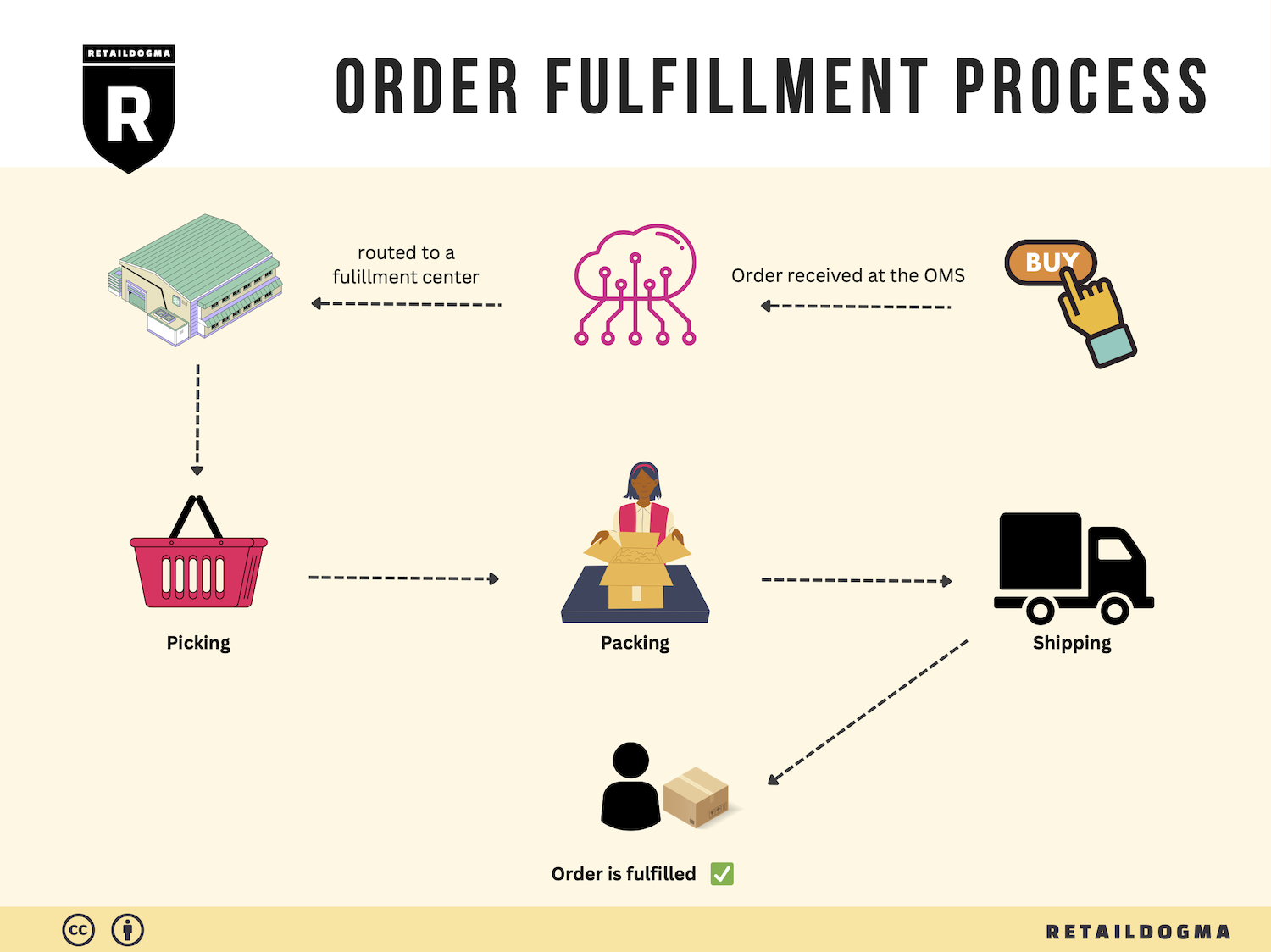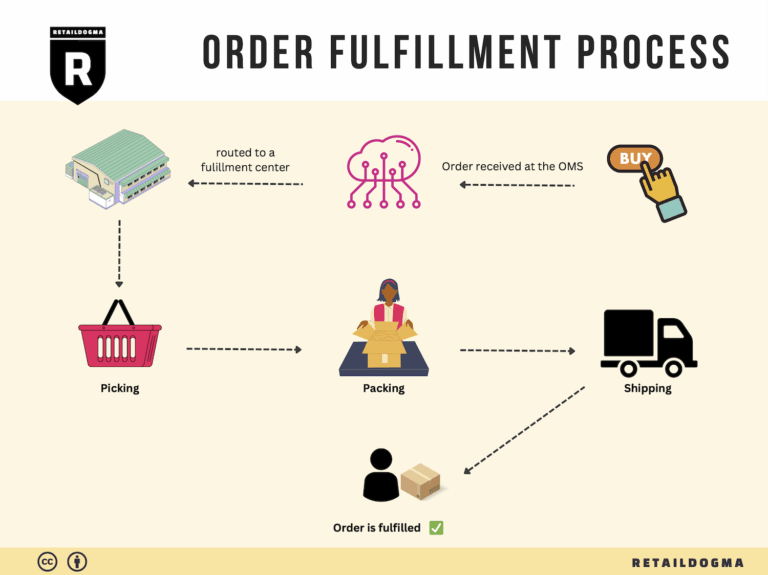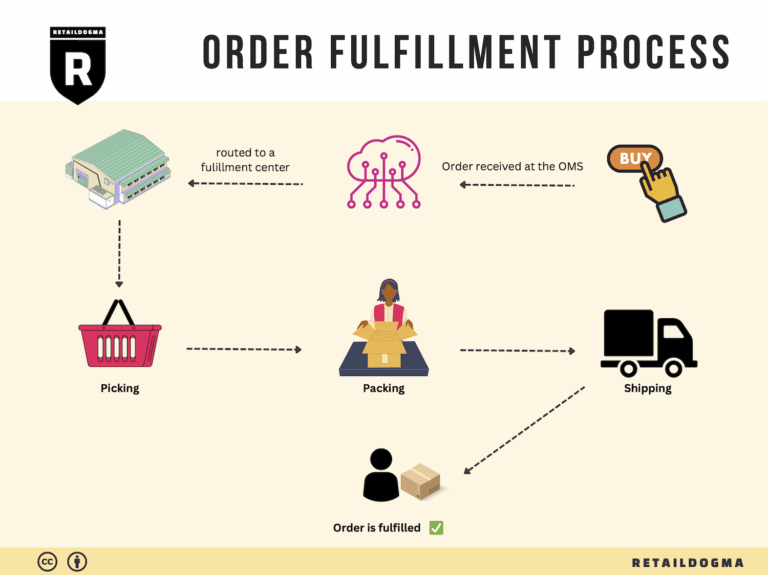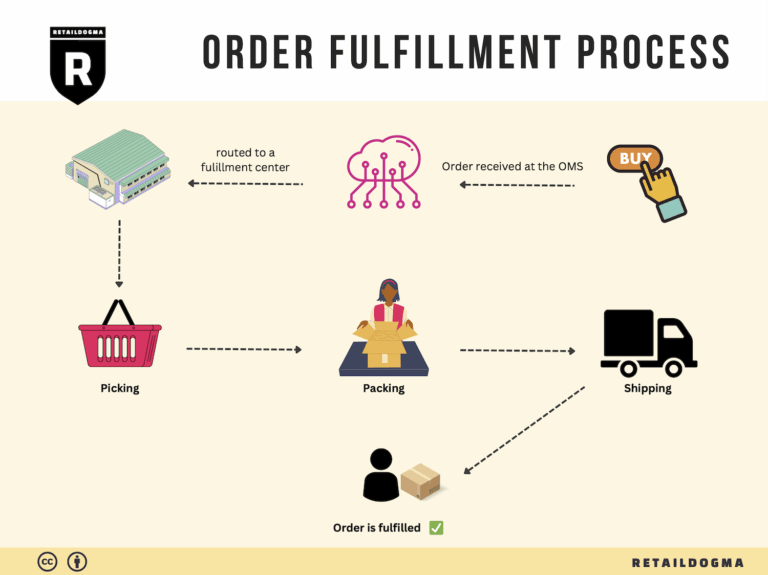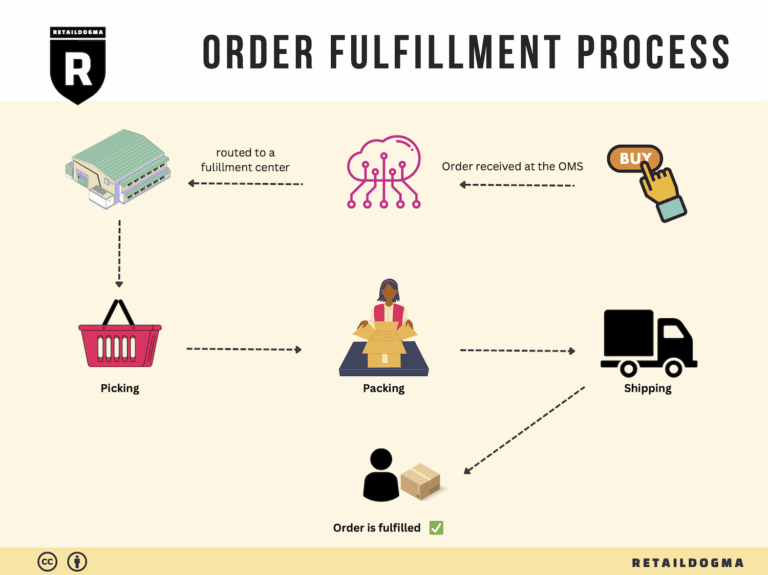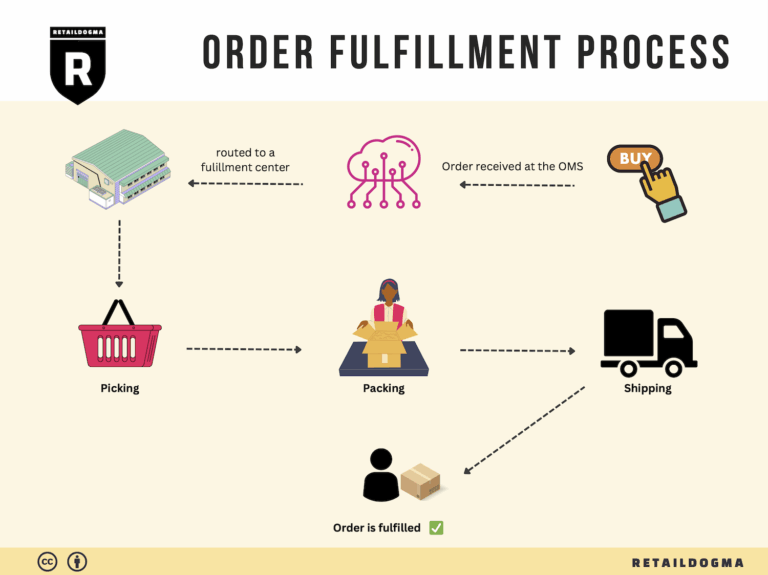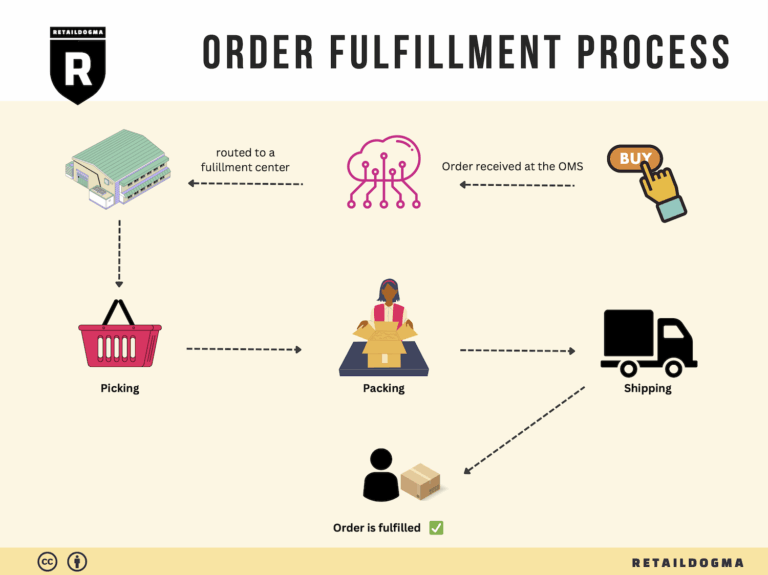How Order Fulfillment Works: A Step-by-Step Guide for Businesses
What is E-commerce Fulfillment? An Introduction for Growing Businesses
The Challenge of Order Management in E-commerce
As an e-commerce business owner, you may find yourself overwhelmed by the complexities of packing and shipping orders. Managing logistics can quickly become a daunting task, especially as your sales grow. From sourcing products to ensuring timely delivery, the fulfillment process can consume valuable time and resources, hindering your ability to focus on scaling your business. This is where understanding e-commerce fulfillment becomes crucial.
Defining E-commerce Fulfillment
At its core, e-commerce fulfillment is the process of getting a product from your inventory to your customer’s doorstep. It encompasses everything from receiving inventory, storing it, and processing orders to packing and shipping those orders efficiently. A well-structured fulfillment strategy not only enhances customer satisfaction but also streamlines your operations, allowing you to devote more energy to marketing, product development, and customer engagement.
What This Guide Covers
In this guide, we will explore various models of e-commerce fulfillment, including Third-Party Logistics (3PL) and Fulfillment by Amazon (FBA). Each model has its unique advantages and challenges, and understanding these will help you choose the best fit for your business needs.
We will delve into core fulfillment services, such as inventory management, order processing, packaging, shipping, and returns handling. Knowing these elements is key to building a robust logistics framework that can adapt as your business scales.
Choosing the right fulfillment partner is another critical aspect we will discuss. Factors such as location, technology capabilities, service offerings, and pricing structures can significantly impact your logistics efficiency and customer satisfaction. We will provide practical insights to help you evaluate potential partners effectively.
Finally, we will break down pricing considerations associated with different fulfillment models. Understanding the costs involved will enable you to budget appropriately and maximize your profit margins.
Empowering Your Business Decisions
The goal of this guide is to empower you to make informed decisions about your logistics strategy. By understanding the nuances of e-commerce fulfillment, you can optimize your operations, improve customer experiences, and ultimately drive your business growth. Whether you’re just starting or looking to refine your existing logistics processes, this guide will serve as a valuable resource in navigating the complexities of e-commerce fulfillment.
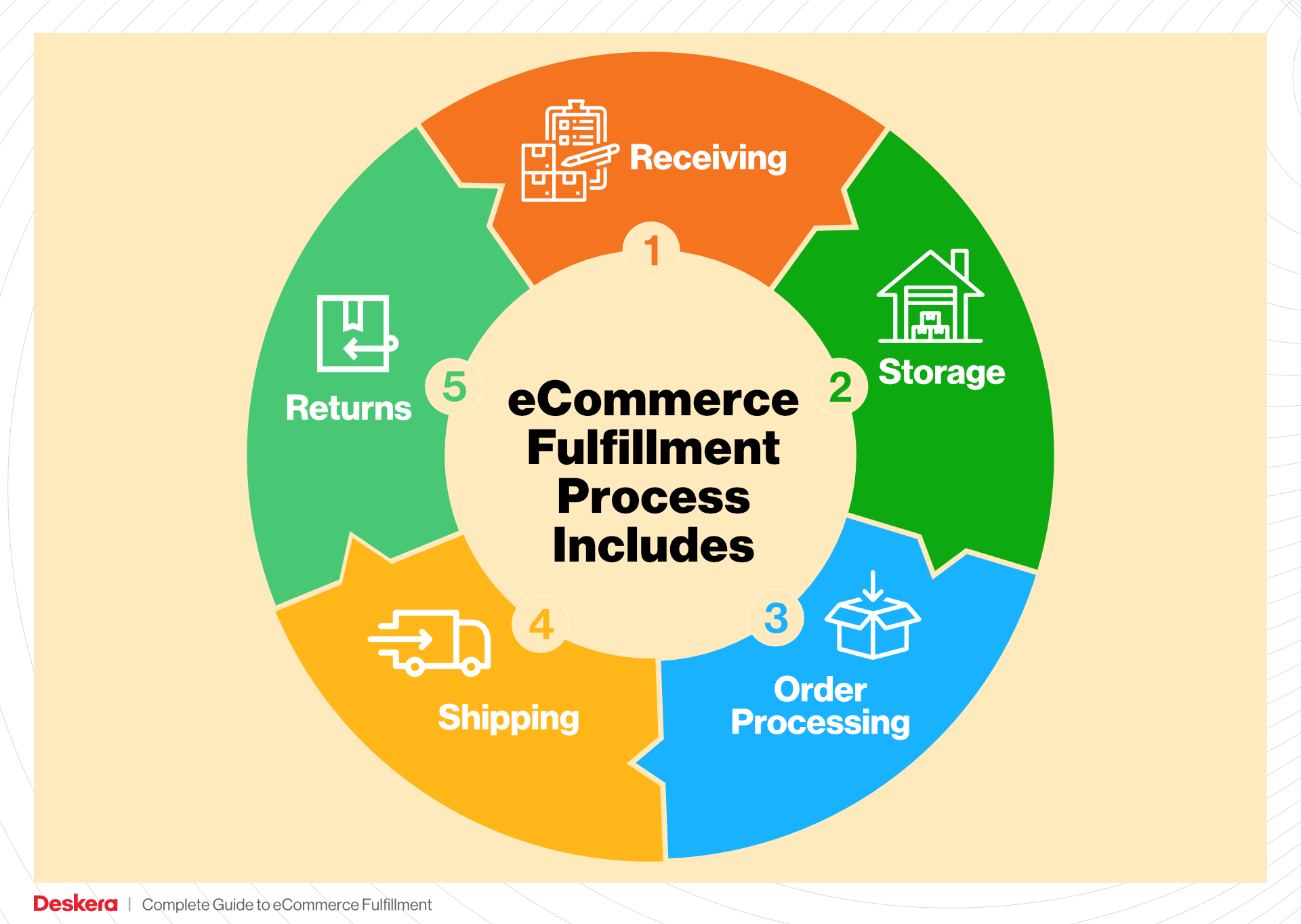
What You’ll Learn In This Guide
- What is E-commerce Fulfillment? An Introduction for Growing Businesses
- The Order Fulfillment Process: From ‘Buy’ Button to Customer’s Door
- Comparing Fulfillment Models: In-House vs. 3PL vs. Dropshipping
- A Deep Dive into Amazon FBA: Pros, Cons, and Who It’s For
- Core Services Offered by Fulfillment Centers
- How to Choose a Fulfillment Partner: A 6-Point Checklist
- Understanding Fulfillment Pricing: A Breakdown of Common Fees
- Frequently Asked Questions (FAQs) about Fulfillment
- Conclusion: Is Outsourcing Fulfillment the Right Move for Your Business?
- Important Disclaimer
The Order Fulfillment Process: From ‘Buy’ Button to Customer’s Door
1. Receiving Inventory
The order fulfillment process begins with receiving inventory at the fulfillment center. This step is crucial as it sets the foundation for the entire supply chain. When products arrive at the facility, they are unloaded and checked against purchase orders to ensure accuracy. This involves verifying quantities, inspecting for damages, and confirming that the correct items have been delivered.
Importance: Effective inventory receiving helps prevent stock discrepancies and minimizes returns due to incorrect shipments. It also ensures that the inventory is ready for storage and subsequent order processing.
Key Term: SKU (Stock Keeping Unit) – Each product is assigned a unique SKU that aids in tracking inventory levels and managing stock efficiently. This code helps streamline the receiving process, ensuring that every item is accounted for and stored correctly.
2. Warehouse Storage
Once inventory has been received and validated, the next step is warehouse storage. Products are organized in designated areas within the fulfillment center. Efficient storage systems are critical for optimizing space and facilitating quick access to items when orders are placed.
Importance: Proper warehouse storage reduces retrieval times during order picking, leading to faster order fulfillment. Additionally, organized storage minimizes the risk of errors when locating products, which is essential for maintaining customer satisfaction.
Key Term: ABC Analysis – This inventory categorization technique helps prioritize the storage of items based on their sales volume and value. High-demand products (A items) are placed closer to the picking area, while lower-demand items (C items) can be stored further away.
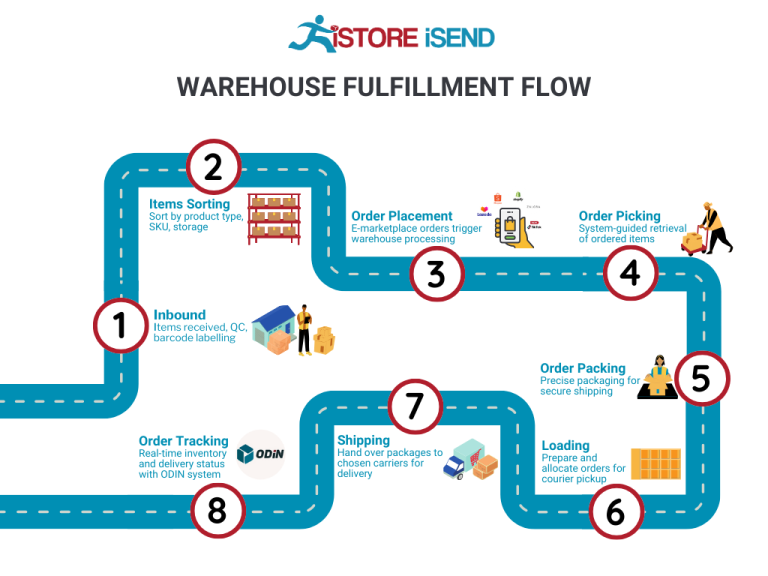
3. Order Picking
When a customer places an order, the next step is order picking, where warehouse staff locate and retrieve the items from storage. This process can be carried out using various methods, such as batch picking, zone picking, or wave picking, depending on the fulfillment center’s operations.
Importance: Efficient order picking is vital for maintaining a fast turnaround time. The quicker the picking process, the sooner the order can be packed and shipped, which is critical in today’s e-commerce landscape where customers expect rapid delivery.
Key Term: Pick Lists – These are documents or digital lists that specify which items need to be picked for each order. They help streamline the picking process by providing clear instructions and reducing the chances of errors.
4. Order Packing
After items have been picked, they move to the order packing stage. In this step, products are carefully packed into boxes or envelopes, ensuring they are secure for transit. Packaging materials such as bubble wrap, packing peanuts, or custom-fit boxes may be used to protect items during shipping.
Importance: Proper packing is essential to prevent damage during transit, which can lead to costly returns and unhappy customers. Additionally, effective packing ensures that shipping costs are optimized, as overpacking can result in higher shipping fees.
Key Term: Packing Slips – These are included in the package and provide customers with a summary of the items in their order. They serve as a confirmation of what was shipped and can also facilitate returns if needed.
5. Shipping & Delivery
The final step in the order fulfillment process is shipping and delivery. Once orders are packed, they are labeled and handed off to carriers for delivery. The choice of shipping method—standard, expedited, or same-day—can greatly impact customer satisfaction and operational efficiency.

Importance: Timely shipping is a key factor in customer experience. Fast and reliable delivery can lead to repeat business and positive reviews, while delays can result in frustration and lost customers.
Key Term: Last-Mile Delivery – This term refers to the final step of the delivery process, where the package is transported from a transportation hub to the customer’s doorstep. Efficient last-mile delivery is critical for achieving customer satisfaction, particularly in urban areas where logistics can be complex.
By understanding and optimizing each step of the order fulfillment process, e-commerce businesses can enhance operational efficiency, reduce costs, and ultimately improve customer satisfaction. As competition in the e-commerce space continues to grow, mastering these processes will be essential for scaling and sustaining success.
Comparing Fulfillment Models: In-House vs. 3PL vs. Dropshipping
Fulfillment Model Comparison Table
| Model | Who Handles Inventory | Best For (Business Stage) | Key Advantage | Key Disadvantage |
|---|---|---|---|---|
| In-House Fulfillment | The business itself | Established businesses with stable sales | Greater control over inventory and operations | Higher overhead costs |
| Third-Party Logistics (3PL) | A third-party provider | Growing businesses scaling operations | Cost efficiency and scalability | Less control over inventory and fulfillment speed |
| Dropshipping | Suppliers | Startups and entrepreneurs testing markets | Low upfront investment and risk | Lower profit margins and potential quality issues |
In-House Fulfillment
In-house fulfillment refers to the practice of managing all aspects of inventory and order processing within the business itself. This model is typically adopted by established businesses that have a stable sales volume and are looking to maintain greater control over their supply chain. One of the primary advantages of in-house fulfillment is the level of control it provides. Businesses can directly oversee inventory management, quality control, and customer service, ensuring that every aspect meets their standards. This model also allows for personalized customer experiences, as companies can tailor their fulfillment processes to better align with their brand image.
However, the disadvantages are significant. The overhead costs associated with maintaining a warehouse, hiring staff, and managing logistics can be substantial, particularly for smaller businesses. Additionally, as order volume increases, the complexities of in-house operations can lead to inefficiencies and potential bottlenecks, especially if the business lacks the necessary infrastructure or expertise. Therefore, while in-house fulfillment can offer advantages in control and customization, it requires a significant investment in resources and management capabilities.
Third-Party Logistics (3PL)
Third-party logistics (3PL) providers offer businesses an outsourced solution for inventory management and order fulfillment. This model is particularly beneficial for growing businesses that are scaling their operations and need to manage increased order volume without the associated overhead costs of in-house fulfillment. 3PL providers handle everything from warehousing to shipping, allowing businesses to focus on core activities like marketing and product development. The key advantage of using a 3PL is cost efficiency; businesses can leverage the provider’s established infrastructure and expertise, which can lead to significant savings on logistics and operational costs.
However, relying on a 3PL also comes with its challenges. Businesses may find they have less control over their inventory and fulfillment processes, which can lead to delays or discrepancies in order processing. Additionally, the quality of service can vary greatly between providers, and businesses must invest time in selecting a reputable partner that aligns with their operational needs. Communication issues can also arise if the 3PL does not provide timely updates or if their systems are not fully integrated with the business’s own. As such, while 3PLs can offer scalability and reduced costs, careful consideration is required to ensure that service levels meet customer expectations.
Dropshipping
Dropshipping is a fulfillment model that allows businesses to sell products without holding inventory. Instead, when a customer places an order, the business purchases the item from a third-party supplier, who then ships it directly to the customer. This model is particularly appealing for startups and entrepreneurs looking to test new markets with minimal upfront investment and risk. One of the primary advantages of dropshipping is the low barrier to entry; businesses do not need to invest heavily in inventory or warehousing, which reduces financial risk. Additionally, the model allows for a wide range of products to be offered without the need for significant capital investment.
However, dropshipping is not without its drawbacks. The most significant disadvantage is the lower profit margins; businesses often have to pay wholesale prices and cannot control the retail price as effectively as they could with in-house fulfillment. Moreover, quality control can be problematic, as businesses rely on suppliers to ensure product quality and timely shipping. This can lead to customer dissatisfaction if orders are delayed or if products do not meet expectations. Therefore, while dropshipping offers flexibility and low risk, it can also present challenges in terms of profitability and customer satisfaction.
Conclusion
Choosing the right fulfillment model is critical for e-commerce success. Each model—whether in-house fulfillment, third-party logistics, or dropshipping—has its unique advantages and disadvantages, making it essential for businesses to assess their operational needs, financial situation, and growth stage before making a decision. By understanding the implications of each model, e-commerce businesses can better position themselves for scalability and success in the competitive online marketplace.
A Deep Dive into Amazon FBA: Pros, Cons, and Who It’s For
Understanding Fulfillment by Amazon (FBA)
Fulfillment by Amazon (FBA) is a service provided by Amazon that allows e-commerce sellers to store their products in Amazon’s fulfillment centers. Amazon takes care of storage, packaging, and shipping of the products directly to customers. This service is particularly beneficial for businesses looking to leverage Amazon’s vast logistics network to enhance their customer service and operational efficiency.
How FBA Works
-
Product Listing and Preparation: Sellers create product listings on Amazon and prepare their items for shipment to Amazon’s fulfillment centers. This involves labeling products according to Amazon’s guidelines.
-
Shipping to Amazon: Sellers send their inventory to Amazon’s fulfillment centers. They can choose to ship to one or multiple centers based on Amazon’s recommendations.
-
Storage: Once received, products are stored in Amazon’s warehouses. Sellers are charged a monthly storage fee based on the amount of space their products occupy.
-
Order Fulfillment: When a customer places an order for a product, Amazon picks, packs, and ships the product on behalf of the seller. This allows for fast shipping options, including Prime delivery.
-
Customer Service and Returns: Amazon also handles customer service inquiries and returns for FBA orders, providing a seamless experience for customers.
Pros of FBA
-
Prime Eligibility: Products fulfilled by Amazon are automatically eligible for Amazon Prime, giving sellers access to millions of Prime members. This can significantly increase sales, as Prime members tend to shop more frequently and spend more.
-
Customer Trust: Amazon’s brand reputation for reliability and customer service extends to FBA sellers. Customers are more likely to trust and purchase from sellers using FBA, knowing that Amazon is handling their orders.
-
Multi-Channel Fulfillment: FBA allows sellers to fulfill orders from other sales channels (like their own website or eBay) using Amazon’s logistics network. This capability simplifies inventory management and shipping processes across different platforms.
-
Scalability: FBA allows businesses to scale without the need for significant investment in logistics infrastructure. Sellers can easily increase their inventory and reach more customers without worrying about the complexities of order fulfillment.
-
Time-Saving: By outsourcing fulfillment to Amazon, sellers can focus on other critical aspects of their business, such as product development and marketing.
Cons of FBA
-
High Fees: FBA comes with various fees, including storage fees and fulfillment fees. These can add up, especially for sellers with low margins or those selling slow-moving products.
-
Strict Inventory Rules: Amazon has stringent inventory management rules, including limits on the number of units that can be stored and strict guidelines on product condition. Failing to adhere to these rules can lead to penalties or loss of FBA privileges.
-
Commingling Risks: FBA products from different sellers are stored together, which can lead to commingling. This means that if a customer returns a product, it may be difficult for sellers to ensure that their specific product is returned, potentially leading to issues with product quality and brand reputation.
-
Lack of Control: Sellers relinquish control over the fulfillment process. This can be a disadvantage for those who want to maintain a specific level of service or branding in their shipping and handling.
-
Complex Return Handling: While Amazon manages returns, the process can sometimes be complex for sellers. They may face challenges in dealing with returns, especially if items are damaged or not returned in their original condition.
Who is FBA Best For?
Fulfillment by Amazon is best suited for a variety of sellers, particularly:
-
Small to Medium-Sized Businesses: FBA allows these businesses to compete with larger retailers without the overhead of managing their own logistics.
-
Sellers with High Sales Volume: Businesses that can maintain a steady flow of sales can benefit from the economies of scale that FBA offers, reducing per-unit fulfillment costs.
-
Brands Looking to Build Trust: New or lesser-known brands can leverage Amazon’s reputation to gain customer trust and visibility.
-
Entrepreneurs Scaling Their Operations: For those looking to grow their business rapidly, FBA provides a way to scale without the complexities of logistics management.
-
Multi-Channel Sellers: Businesses selling on multiple platforms can simplify their fulfillment processes by using FBA to manage inventory and shipping.
In conclusion, while FBA offers significant advantages in terms of scalability, customer trust, and operational efficiency, it is essential for sellers to weigh these benefits against the potential downsides, such as fees and loss of control. A thorough understanding of FBA will help e-commerce business owners make informed decisions that align with their growth strategies and operational goals.
Core Services Offered by Fulfillment Centers
Inventory Management & Warehousing
Effective inventory management is the backbone of any successful e-commerce operation. Fulfillment centers, such as the one located in Spokane Valley, provide comprehensive inventory management services that include receiving, storing, and tracking products. These facilities utilize sophisticated inventory management software to maintain accurate stock levels, automate reorder processes, and provide real-time visibility into inventory status.
Benefits to E-Commerce Businesses:
-
Reduced Overhead Costs: By outsourcing inventory storage to a fulfillment center, e-commerce businesses can eliminate the costs associated with maintaining their own warehouse space, including rent, utilities, and maintenance.
-
Scalability: As your business grows, fulfillment centers can easily accommodate increased inventory levels without the need for significant capital investment. This flexibility allows businesses to scale operations seamlessly according to market demand.
-
Improved Accuracy: Advanced inventory management systems minimize human error in stock counting and order fulfillment, ensuring that businesses maintain accurate stock levels and reducing the risk of stockouts or overstock situations.
Pick and Pack Services
Pick and pack services are essential for efficiently preparing orders for shipment. In this process, fulfillment center staff pick items from the warehouse based on customer orders, pack them securely, and prepare them for shipping. This service is particularly beneficial for e-commerce businesses that handle a diverse range of products, including bulk items as seen in the Spokane Valley facility.
Benefits to E-Commerce Businesses:
-
Time Efficiency: Fulfillment centers specialize in streamlined picking and packing processes, which significantly reduces the time from order placement to shipment. This efficiency can enhance customer satisfaction through faster delivery times.
-
Professional Packing: Fulfillment centers use high-quality packing materials and methods to ensure that products are protected during transit. This reduces the likelihood of damage and returns, which can be costly for businesses.
-
Order Customization: Many fulfillment centers offer customized packing options, allowing businesses to include branded materials or special instructions in their shipments, enhancing the overall customer experience.
Kitting and Assembly
Kitting and assembly services involve the grouping of different products into a single package or the assembly of components into a finished product. This service is particularly useful for businesses that sell bundled products or require assembly before shipping. Fulfillment centers like the one in Spokane Valley can handle complex kitting and assembly tasks, ensuring that products are ready for sale upon delivery.
Benefits to E-Commerce Businesses:
-
Increased Sales Opportunities: By offering bundled products, businesses can encourage larger purchases. Kitting allows e-commerce companies to create attractive packages that appeal to customers, potentially increasing average order value.
-
Labor Efficiency: Outsourcing kitting and assembly tasks to a fulfillment center frees up internal resources, allowing businesses to focus on core activities such as marketing and product development.
-
Quality Control: Fulfillment centers maintain strict quality control measures during the kitting and assembly process, ensuring that products meet the necessary standards before reaching customers. This reduces the risk of returns and enhances brand reputation.
Returns Management (Reverse Logistics)
Returns management, or reverse logistics, is a critical service offered by fulfillment centers. This involves the processing of returned items, including inspections, restocking, and handling refunds or exchanges. Efficient returns management is vital for maintaining customer satisfaction and loyalty in the e-commerce landscape, where return rates can be significant.
Benefits to E-Commerce Businesses:
-
Streamlined Return Processes: Fulfillment centers have established processes for handling returns, which can significantly speed up the time it takes to process refunds or exchanges. This responsiveness can enhance customer trust and satisfaction.
-
Data Insights: Analyzing return data can provide valuable insights into product performance and customer preferences. Understanding why items are returned can help businesses improve product offerings and reduce future return rates.
-
Cost Savings: By efficiently managing returns, fulfillment centers can minimize the costs associated with reverse logistics. Proper handling of returned items can also lead to opportunities for refurbishment or resale, further offsetting losses.
In conclusion, leveraging the core services provided by fulfillment centers, such as inventory management, pick and pack, kitting and assembly, and returns management, can significantly enhance the operational efficiency of e-commerce businesses. These services not only streamline logistics but also contribute to improved customer satisfaction and scalability, essential for growth in today’s competitive market.
How to Choose a Fulfillment Partner: A 6-Point Checklist
Location & Warehouse Network
Importance: The geographical location of your fulfillment partner’s warehouses plays a crucial role in your logistics efficiency. A partner with strategically located warehouses can significantly reduce shipping times and costs, especially for businesses targeting specific regions.
Questions to Ask:
– Where are your warehouses located, and how do these locations align with my target markets?
– Can you accommodate my shipping needs for both local and national deliveries?
– How do you handle distribution for larger items or bulk orders?
Technology & Integrations
Importance: In the fast-paced world of e-commerce, technology is a game-changer. A fulfillment partner should offer advanced technology solutions that integrate seamlessly with your existing systems, ensuring real-time inventory tracking, order processing, and reporting.
Questions to Ask:
– What warehouse management system (WMS) do you use, and how does it integrate with my e-commerce platform?
– Can you provide API access for real-time updates on order status and inventory levels?
– How do you manage returns, and is there a technology solution in place to streamline this process?
Specializations (e.g., cold storage, oversized items)
Importance: Different businesses have unique needs, such as handling perishable goods, oversized items, or fragile products. A partner’s specialization can ensure that your products are stored and shipped correctly, maintaining quality and compliance.
Questions to Ask:
– Do you have facilities equipped for specific product needs, such as cold storage for perishables or specialized handling for fragile items?
– How do you manage inventory for specialized products, and what safety measures are in place?
– Can you accommodate seasonal fluctuations in demand for specialized items?
Scalability & Capacity
Importance: As your business grows, your fulfillment needs will change. A suitable partner should have the capacity to scale operations alongside your growth, whether that means increasing storage space, workforce, or technology capabilities.
Questions to Ask:
– How do you handle seasonal demand spikes, and what provisions are in place to scale operations?
– What is your maximum storage capacity, and how quickly can you expand if needed?
– Are there any limitations on the types of products you can fulfill as we scale?
Pricing and Contracts
Importance: Understanding pricing structures is vital for budgeting and forecasting. A transparent pricing model can prevent unexpected costs and ensure that you’re getting value for your investment.
Questions to Ask:
– Can you provide a detailed breakdown of your pricing model, including storage fees, pick-and-pack costs, and shipping rates?
– Are there any hidden fees or surcharges that I should be aware of?
– What are the terms of your contracts, and how flexible are they if my needs change?
Customer Support & Reviews
Importance: Excellent customer support can make a significant difference in your operations. A responsive partner can resolve issues quickly, ensuring that your customers receive their orders on time and in good condition. Additionally, checking reviews and testimonials can provide insight into a partner’s reliability and service quality.
Questions to Ask:
– What kind of customer support do you offer (e.g., dedicated account manager, 24/7 support)?
– How do you handle disputes or issues related to order fulfillment?
– Can you provide references or case studies from businesses similar to mine?
By carefully evaluating potential fulfillment partners against this checklist, you can make an informed decision that aligns with your business goals and enhances your operational efficiency. Each point is critical in ensuring that your logistics partner can meet your current needs and adapt as your business scales.
Understanding Fulfillment Pricing: A Breakdown of Common Fees
Initial Setup Fees
Initial setup fees are the costs associated with establishing your account with a fulfillment provider. This typically includes onboarding processes such as account configuration, integration with your e-commerce platform, and initial consultations to tailor services to your business needs.
The calculation of these fees can vary significantly between providers. Some may charge a flat fee, while others might base it on the complexity of the integration or the volume of products you will be fulfilling. For example, if you are using Amazon’s fulfillment services, initial setup fees may be lower due to their standardized processes, while a smaller, more specialized fulfillment center might require a higher fee for customized service.
Receiving Fees
Receiving fees are charged when your inventory arrives at the fulfillment center. This fee covers the labor and resources required to unload, inspect, and process your products into the warehouse system.
Typically, receiving fees are calculated on a per-unit basis or can be based on the total weight of the shipment. For example, a fulfillment center may charge $0.30 per item received or a flat fee based on weight, such as $50 for shipments under 500 pounds. Understanding the specifics of how receiving fees are calculated is crucial, as variations can significantly impact your overall fulfillment costs.
Storage Fees (per pallet/bin)
Storage fees are incurred for the space your inventory occupies within the fulfillment center. This fee is essential to consider, especially if you have a large inventory or products that sell slowly.
Storage fees are usually calculated on a monthly basis and can be charged per pallet or per bin. For instance, a typical fee structure might be $20 per pallet per month or $5 per bin per month. Some fulfillment centers also implement tiered pricing, where the fee decreases based on the number of pallets or bins stored. It’s important to monitor your inventory levels to minimize storage costs, as excess stock can lead to increased fees.
Pick & Pack Fees (per item/order)
Pick and pack fees are associated with the process of retrieving items from storage and packaging them for shipment. This fee is vital for understanding the operational costs of order fulfillment.
Pick and pack fees can vary widely based on the complexity of the order. Some fulfillment centers charge a flat fee per order, while others charge based on the number of items picked. For example, a fulfillment center might charge $1.00 per order and an additional $0.50 for each item picked. If your business frequently has multi-item orders, it is essential to understand how these fees accumulate, as they can quickly add up and affect your profit margins.
Shipping Fees
Shipping fees are one of the most significant costs associated with fulfillment services. These fees cover the transportation of packages from the fulfillment center to the customer’s location.
Shipping fees can be calculated based on several factors, including the weight and dimensions of the package, the shipping method chosen (standard, expedited, etc.), and the destination. Many fulfillment centers have partnerships with major carriers, allowing them to negotiate better rates that can be passed on to their clients. For example, a provider might offer a flat rate for domestic shipping or variable rates based on weight, such as $5 for packages under 5 pounds and increasing as the weight goes up. Understanding the shipping options and costs available to you is crucial for budgeting and pricing your products effectively.
Tips for Getting an Accurate Quote
-
Be Transparent About Your Needs: When requesting quotes, provide detailed information about your business model, including average order volume, item dimensions, and storage requirements. This transparency helps fulfillment centers give you tailored quotes.
-
Request a Breakdown of Fees: Ask for a detailed breakdown of all potential fees, including any hidden costs. This will help you understand the total cost of fulfillment and avoid surprises later.
-
Compare Multiple Providers: Don’t settle for the first quote you receive. Compare multiple fulfillment providers to see who offers the best overall value, taking into account service levels, technology integration, and pricing.
-
Understand the Terms: Clarify any contractual terms or commitments required by the fulfillment center. Some providers may have minimum volume requirements or long-term contracts that could impact your flexibility.
-
Ask About Discounts and Promotions: Inquire if there are any discounts available for high-volume shipments or seasonal promotions that could reduce your costs.
By taking these steps, you can secure a more accurate and comprehensive understanding of your fulfillment pricing, ultimately aiding in more informed decision-making as you scale your business.
Frequently Asked Questions (FAQs) about Fulfillment
1. What is the Amazon Fulfillment Center in Spokane Valley?
The Amazon Fulfillment Center in Spokane Valley, located at 18007 E Garland Ave, is a 1.3 million-square-foot facility that primarily handles larger items such as bulk goods, cleaning supplies, pet food, and outdoor equipment. It plays a crucial role in Amazon’s logistics network, ensuring efficient order processing and delivery for customers in the region.
2. What types of jobs are available at the Spokane Fulfillment Center?
The Spokane Fulfillment Center offers a range of job opportunities, including roles in receiving and stowing inventory, picking and packing orders, and shipping. Positions start at $17 per hour and come with benefits such as health insurance, dental, vision, and a 401(k). Additionally, employees may access Amazon’s Career Choice program, which covers 95% of tuition for courses in high-demand fields after one year of employment.
3. How does Amazon’s fulfillment process work?
Amazon’s fulfillment process involves several key steps:
1. Receiving Inventory: Products are received and checked into the system.
2. Stowing: Items are stored in designated locations within the warehouse.
3. Picking: When an order is placed, items are retrieved from their storage locations.
4. Packing: Retrieved items are packed securely for shipment.
5. Shipping: Packages are dispatched to customers via various delivery options.
4. What is the difference between a warehouse and a fulfillment center?
A warehouse is primarily used for storing goods, while a fulfillment center is designed for order processing and shipping. Fulfillment centers focus on efficiently managing inventory, picking, packing, and delivering products directly to customers, often with an emphasis on speed and accuracy.
5. What is a third-party logistics provider (3PL)?
A third-party logistics provider (3PL) is a company that offers logistics services to businesses, handling aspects such as warehousing, fulfillment, and distribution. By partnering with a 3PL, e-commerce businesses can leverage expertise and infrastructure to streamline their supply chain operations without managing these functions in-house.
6. How much do fulfillment services cost?
Fulfillment service costs can vary widely depending on factors such as order volume, storage space, and the types of services required. Generally, businesses can expect to pay for storage fees (per pallet or cubic foot), picking and packing fees (per order), and shipping costs. It’s essential for businesses to evaluate their specific needs and obtain quotes from providers to determine overall costs.
7. Does the Spokane Fulfillment Center offer same-day delivery?
While the Spokane Fulfillment Center facilitates faster delivery of larger items to local customers, same-day delivery is not guaranteed. The center also fulfills orders from areas outside the region, which can impact delivery times.
8. What products are mainly handled at the Spokane Fulfillment Center?
The Spokane Fulfillment Center primarily handles larger items, including bulk paper goods, cleaning supplies, pet food, patio furniture, and outdoor sports equipment. This focus allows Amazon to efficiently serve customers looking for these types of products in the local area.
9. What improvements are being made to the area surrounding the Spokane Fulfillment Center?
The city of Spokane Valley is enhancing infrastructure around the fulfillment center, including the $26 million Barker Road Grade Separation Project, which aims to improve traffic safety by replacing a railroad crossing with an overpass. These improvements will facilitate better access to the fulfillment center and support the growing business community.
10. How does Amazon’s presence in Spokane impact local businesses?
Amazon’s fulfillment center in Spokane is likely to attract more e-commerce companies to the region, boosting the local economy and creating job opportunities. The presence of a major player like Amazon can stimulate interest in logistics and supply chain sectors, encouraging other businesses to establish operations nearby and benefit from the improved infrastructure and workforce.
Conclusion: Is Outsourcing Fulfillment the Right Move for Your Business?
Weighing the Benefits of Outsourcing Fulfillment
Outsourcing fulfillment can be a game-changer for e-commerce businesses aiming for growth. One of the most significant advantages is the time savings it offers. By partnering with a fulfillment service, you can offload time-consuming tasks such as inventory management, order processing, and shipping logistics. This allows you to focus on core business activities like marketing, product development, and customer engagement—essential areas that drive revenue and customer loyalty.
Scalability is another critical benefit. As your business grows, so do your fulfillment needs. A robust fulfillment partner can easily adjust to fluctuations in order volume, seasonal spikes, or even new product launches without the hassle of investing in additional infrastructure or workforce. This flexibility is invaluable for maintaining customer satisfaction while minimizing operational headaches.
Additionally, leveraging the expertise of a fulfillment service can enhance your logistics efficiency. These providers often have established networks, advanced technologies, and industry best practices that can optimize delivery times and reduce shipping costs. This expertise not only improves your service levels but also provides you with insights and analytics that can inform your overall business strategy.
However, the choice of a fulfillment partner is paramount. Selecting the wrong partner can lead to service disruptions and damage your brand reputation. Therefore, it’s essential to conduct thorough research and consider factors like location, technology, service offerings, and customer support.
Call to Action
Take the first step towards optimizing your logistics by auditing your current shipping process. Assess whether your existing setup can support your growth ambitions or if a fulfillment partner could enhance your operational efficiency. By evaluating your options, you can make a strategic decision that aligns with your business goals and positions you for success in the competitive e-commerce landscape.
Important Disclaimer
⚠️ Important Disclaimer
The information in this guide is for educational purposes. Fulfillment services, pricing, and platform features change frequently. Always conduct your own due diligence and consult with providers directly before making business decisions.
